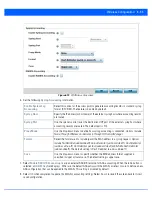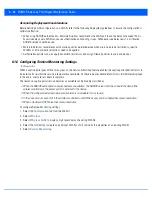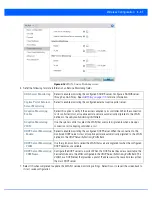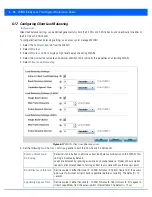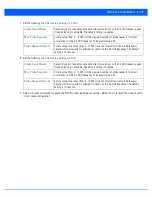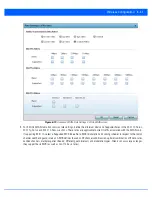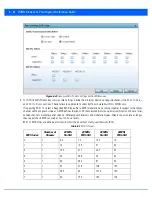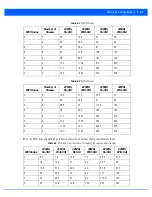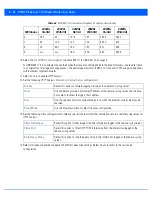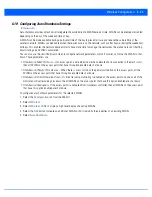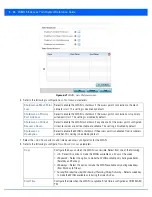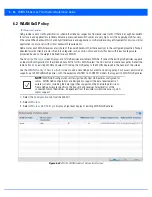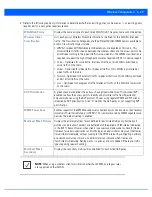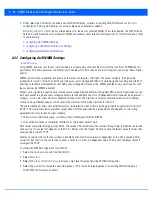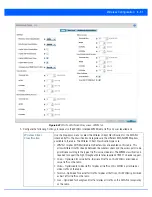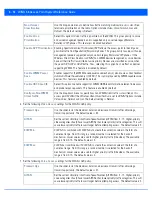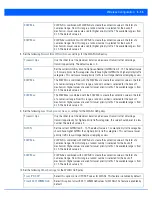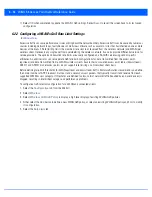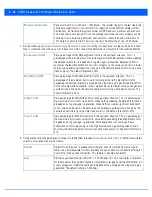
Wireless Configuration 6 - 49
4. Refer to the following read-only information to determine whether an existing policy can be used as is, an existing policy
requires edit or a new policy requires creation:
WLAN QoS Policy
Displays the name assigned to each listed WLAN QoS. The policy name cannot be edited.
Wireless Client
Classification
Lists each policy’s Wireless Client Classification as defined for this WLAN's intended
traffic. The Classification Categories are the different WLAN-WMM options available to
a radio. Classification types include:
•
WMM
– Implies WiFi Multimedia QoS extensions are enabled on this radio. This
allows different traffic streams between the wireless client and the access point to be
prioritized according to the type of traffic (voice, video etc). The WMM classification is
required to support the high throughput data rates required of 802.11n device support.
•
Voice
– Optimized for voice traffic. Implies all traffic on this WLAN is prioritized as
voice traffic on the radio.
•
Video
– Optimized for video traffic. Implies all traffic on this WLAN is prioritized as
video traffic on the radio.
•
Normal
– Optimized for best effort traffic. Implies all traffic on this WLAN is prioritized
as best effort traffic on the radio.
•
Low
– Optimized for background traffic. Implies all traffic on this WLAN is low priority
on the radio.
SVP Prioritization
A green check mark defines the policy as having
Spectralink Voice Prioritization
(SVP)
enabled to allow the access point to identify and prioritize traffic from Spectralink/
Polycomm phones using the SVP protocol. Phones using regular WMM and SIP are not
impacted by SVP prioritization. A red “X” defines the QoS policy as not supporting SVP
prioritization.
WMM Power Save
Enables support for the WMM based power-save mechanism, also known as
Unscheduled
Automatic Power Save Delivery
(U-APSD). This is primarily used by WMM capable voice
devices. The default setting is enabled.
Multicast Mask Primary
Displays the primary multicast mask defined for each listed QoS policy. Normally all
multicast and broadcast packets are buffered until the periodic DTIM interval (indicated
in the 802.11 beacon frame), when clients in power save mode wake to check for frames.
However, for certain applications and traffic types, an administrator may want the frames
transmitted immediately, without waiting for the DTIM interval. By configuring a primary
and secondary multicast mask, an administrator can indicate which frames are
transmitted immediately. Setting masks is optional, and only needed if there are traffic
types requiring special handling.
Multicast Mask
Secondary
Displays the secondary multicast mask defined for each listed QoS policy.
NOTE:
When using a wireless client classification other than WMM, only legacy rates
are supported on that WLAN.
Summary of Contents for WiNG 5.6
Page 1: ...Motorola Solutions WiNG 5 6 ACCESS POINT SYSTEM REFERENCE GUIDE ...
Page 2: ......
Page 22: ...8 WiNG 5 6 Access Point System Reference Guide ...
Page 26: ...1 4 WiNG 5 6 Access Point System Reference Guide ...
Page 38: ...2 12 WiNG 5 6 Access Point System Reference Guide ...
Page 74: ...3 36 WiNG 5 6 Access Point System Reference Guide ...
Page 468: ...6 2 WiNG 5 6 Access Point System Reference Guide Figure 6 1 Configuration Wireless menu ...
Page 568: ...6 102 WiNG 5 6 Access Point System Reference Guide ...
Page 614: ...7 46 WiNG 5 6 Access Point System Reference Guide ...
Page 660: ...8 46 WiNG 5 6 Access Point System Reference Guide ...
Page 716: ...9 56 WiNG 5 6 Access Point System Reference Guide ...
Page 730: ...10 14 WiNG 5 6 Access Point System Reference Guide ...
Page 982: ...14 20 WiNG 5 6 Access Point System Reference Guide ...
Page 984: ...A 2 WiNG 5 6 Access Point System Reference Guide ...
Page 1046: ...B 62 WiNG 5 6 Access Point System Reference Guide ...
Page 1047: ......

